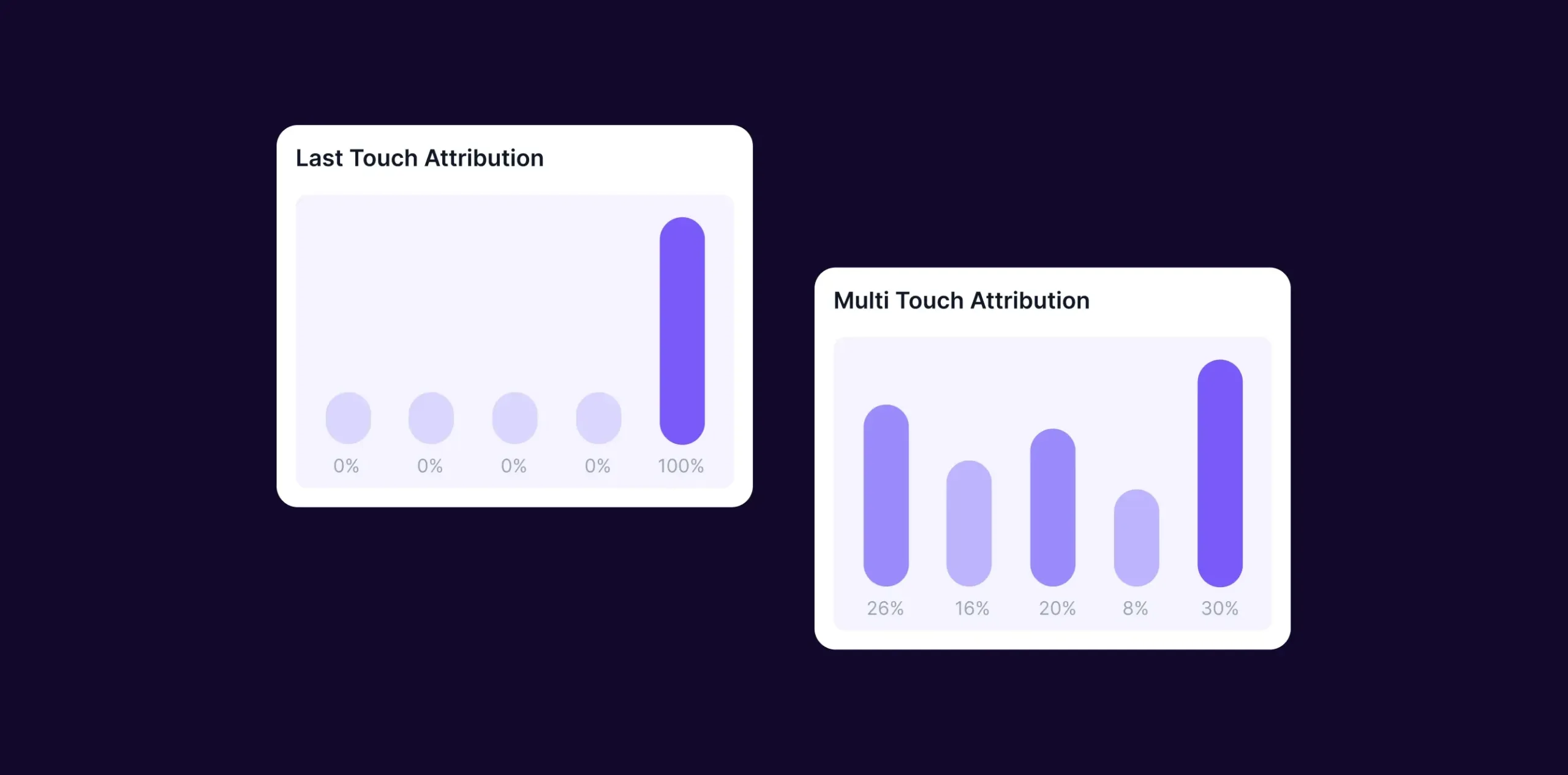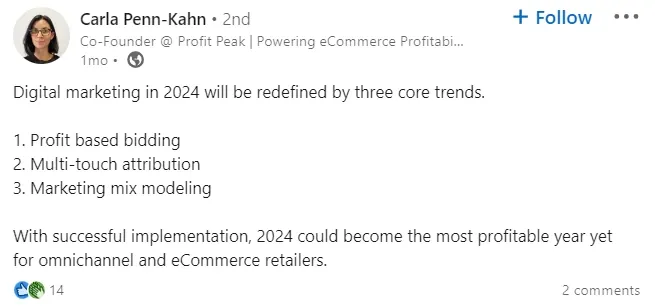When it comes to marketing attribution, two predominant models emerge last touch and multi touch attribution. Both offer unique insights into consumer behavior and campaign effectiveness, but understanding last touch vs multi touch attribution is crucial for optimizing your marketing strategy.
This need for sophisticated understanding becomes more crucial as we navigate the challenges of a privacy-first online world. Stringent privacy regulations like GDPR and CCPA, along with ad blockers and changes in cookie tracking, have posed hurdles to traditional attribution models.
These developments impact how marketers collect and analyze data, leading to potential inaccuracies in attributing sales or conversions to the right channels. Whether you’re a seasoned marketer or new to the field, understanding these models is key to attributing success accurately and optimizing your marketing strategies effectively.
What is Touch-Based Attribution in Marketing?
Attribution in marketing refers to the process of identifying and assigning credit to the various marketing touchpoints that a consumer encounters along their journey towards making a purchase or completing a desired action. This process is crucial in understanding which elements of your marketing strategy are most effective and how they contribute to the end goal.
What is Last Touch Attribution?
Last Touch Attribution is a marketing attribution model where the entire credit for a conversion (such as a sale or lead generation) is attributed to the final touchpoint or interaction that a customer had with the brand before taking the desired action. This model assumes that the most recent interaction is the most significant in the customer’s decision-making process.
For instance, if a customer first discovers a product through a social media ad, then reads a blog post about it, but finally clicks on a search engine ad before making a purchase, the Last Touch Attribution model would assign full credit for the conversion to the search engine ad.
Pros & Cons of Last Touch Attribution
| Aspect | Pros | Cons |
| Simplicity and Implementation | It just tracks the final interaction, making it easy to understand and use. | Neglecting all touchpoints before the final engagement distorts the customer journey. |
| Effectiveness | Can work in short sales cycles or impulse buys where the last interaction matters most. | Not ideal for long sales cycles because the last encounter may not reflect the complete decision-making process. |
| Conversion Optimization | Helps identify channels or campaigns that close sales or convert, delivering rapid optimization insights. | Last-touch data can misallocate the marketing budget by underinvesting in early or middle-stage channels. |
| Marketing Strategy Alignment | Popular among marketers who are new to attribution modeling due to its ease of use. | Neglects upper-funnel marketing like content and social media, which boosts brand visibility and engagement early in the customer journey. |
Multi-Touch Attribution
Multi-Touch Attribution (MTA) is a sophisticated approach in marketing analytics that evaluates the impact of each touchpoint in a customer’s journey towards a conversion. Unlike traditional models that assign credit to just one interaction (such as the first or last click), multi-touch attribution recognizes that modern customer journeys are complex and involve multiple interactions across various channels.
The goal of multi-touch attribution is to accurately distribute credit to each marketing touchpoint (like an ad click, an email open, or a social media engagement), thereby providing a more nuanced understanding of what’s working in a marketing strategy. This information is crucial for marketers looking to optimize their campaigns, allocate budgets effectively, and improve overall marketing ROI.
Exploring Various Multi-Touch Models
- Linear Model: This model assigns equal credit to each touchpoint in the customer journey. It’s straightforward and assumes that all interactions are equally important in driving a conversion.
- Time Decay Model: Here, more credit is given to touchpoints that occur closer to the time of conversion. This model is based on the rationale that the interactions just before conversion play a more significant role in the decision-making process.
- U-Shaped (Position-Based) Model: The U-Shaped model attributes more credit to the first and last touchpoints (usually 40% each), and the remaining 20% is distributed across other touchpoints. This model recognizes the importance of the initial engagement and the final conversion action.
- W-Shaped Model: An extension of the U-Shaped model, it assigns significant credit to three key touchpoints: the first interaction, the lead creation, and the final conversion, recognizing these as critical stages in the customer journey.
- Custom or Algorithmic Model: This model uses algorithms and machine learning to dynamically assign credit to each touchpoint based on how likely they are to contribute to a conversion. It’s tailored to the specific nuances of a business’s marketing strategy and customer behavior.
Aimee Meester, CEO and Chief Marketing Aficionado at Madison Taylor Marketing recommends using multi-touch attribution models to know the impact of social media on the marketing funnel
Aimee-Meester-Explains-the-difference-between-last-touch-vs-multi-touch-attribution
Situational Usage: When to Use Each Model?
Now let’s explore the scenarios where you can use these models to your advantage.
Last Touch Attribution:
- Best used when the sales cycle is short and straightforward.
- Ideal for businesses with a dominant marketing channel that consistently drives conversions.
- Useful in scenarios where budget and resources for complex analytics are limited.
Multi-Touch Attribution:
- Essential for long sales cycles involving multiple touchpoints.
- Crucial for omnichannel marketing strategies where understanding the impact of each channel is necessary for optimization.
- Beneficial in scenarios where marketers aim to understand the customer journey comprehensively and allocate budgets effectively across multiple channels.
Here you find out last touch vs multi touch attribution situational usage. Do Check out this multi-touch attribution case study to learn how a major online plant store used Lifesight’s Multi-Touch Attribution to track their marketing results, make better campaign investments, and learn more about how their customers behave.
An eco-friendly online nursery that had a presence in digital markets. It had all the right buzzwords to stay in the minds of customers. But their growth made us wonder which marketing platforms really increased sales.
Case Study on MTA
The brand used Multi-Touch Attribution to figure out their customers’ journeys and make their marketing strategies work better. This included everything from Google Ads to partnerships with influencers.
Carla Penn-Kahn, co-founder of Profit Peak, suggests that omnichannel and eCommerce businesses embrace three essential trends to achieve profitability in 2024.
- Profit-driven bidding.
- Multi-touch attribution.
- Marketing Mix Modeling.
Carla Penn-Kahn explains three essential trends to achieve profitability in 2024
Endgame
Attribution models serve as the navigational compass that guides marketers through the complex journey of understanding customer interactions and the effectiveness of their marketing efforts. The ideal model sheds light on which touchpoints are most influential, helping in allocating resources efficiently and enhancing the return on investment.
Lifesight’s platform, powered by AI and machine learning, revolutionizes Multi-Touch Attribution by integrating comprehensive customer journey data from online + offline channels, ensuring a complete view for accurate analysis — we call it Universal Attribution. Additionally, our predictive analytics capabilities enable strategic future planning by forecasting customer behaviors based on current data touchpoints.
Are you ready to transform your approach to marketing attribution and decision-making? Book a demo today and unlock the full potential of your marketing strategies.
You may also like
Essential resources for your success



























































